Last Chance to Catch NYC's Holiday Notalgia Train
We met the voices of the NYC subway on our nostalgia ride this weekend!


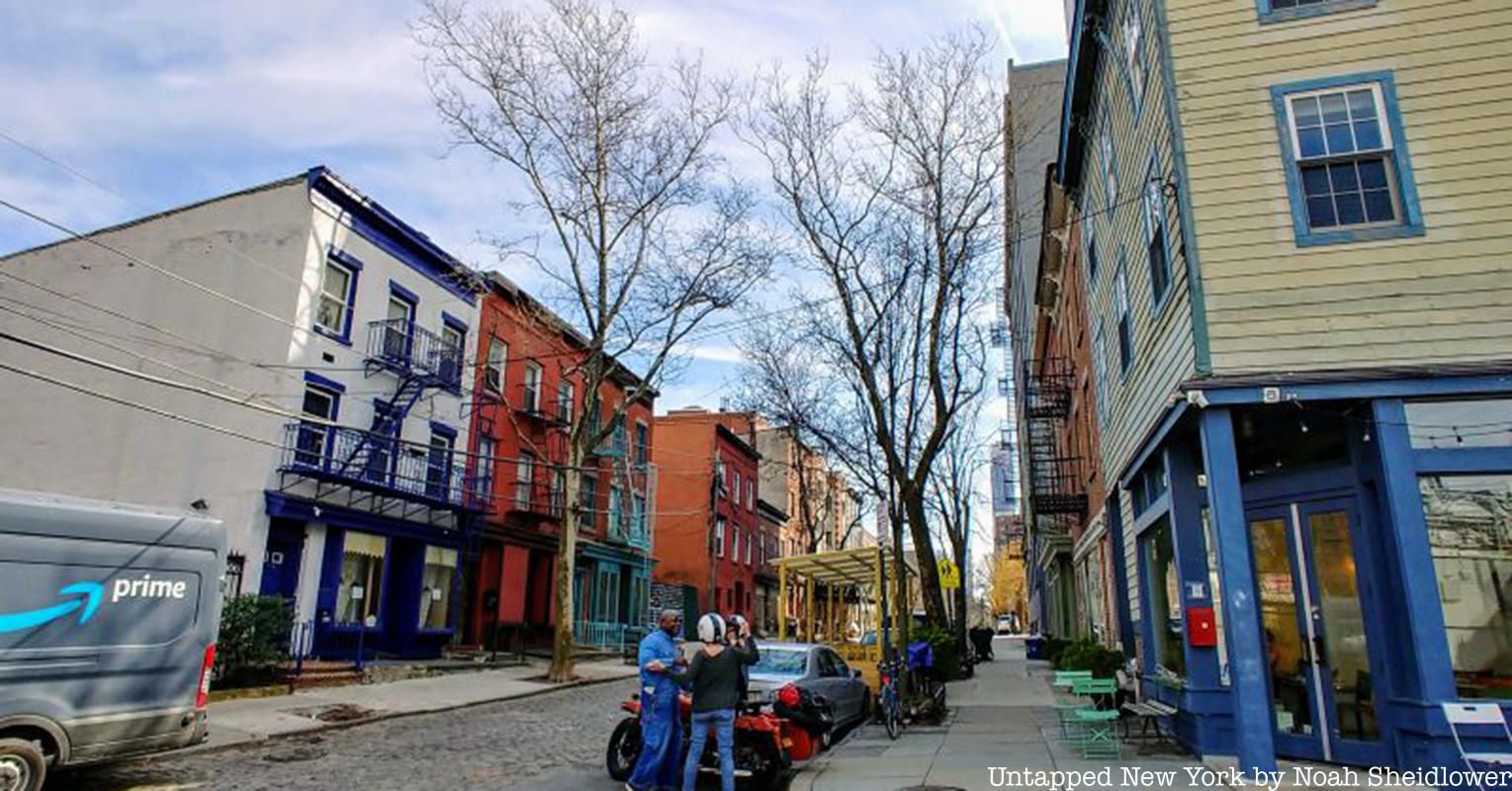
Vinegar Hill, located along the East River waterfront, is one of Brooklyn’s quietest neighborhoods. Sandwiched between DUMBO and the Brooklyn Navy Yard, the small community has a population of about 2,700 and features historic Federal and Greek Revival architecture. Vinegar Hill is often described as a quiet European village, whose off-the-beaten-path tranquil streets feel out of place in Brooklyn. The area has a rich Irish and Lithuanian history, as well as a Tibetan Buddhist center, popular restaurants, and a large mansion previously occupied by Commodore Matthew C. Perry. Here is our guide to the top 10 secrets of Vinegar Hill.
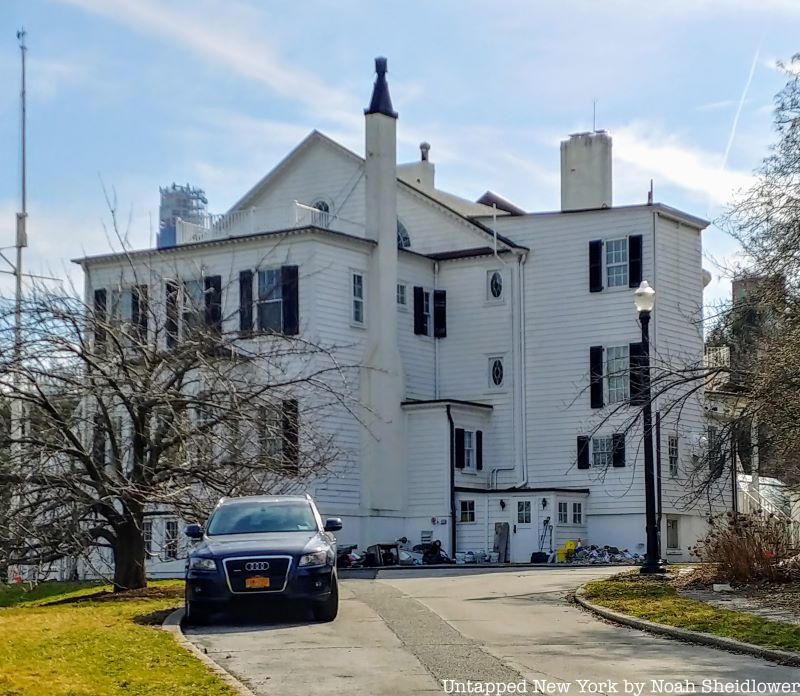
The Commandant’s House, also known as Quarters A, is a historic house on Evans Street which is fully gated off. today The home was built in 1805 as an example of Federal-style architecture, also seen with Gracie Mansion and the Bialystoker Synagogue. The home is located on a bluff overseeing the western side of the Brooklyn Navy Yard, standing at three and a half stories tall with wood-frame construction. Features of the home include front entry sidelight windows and carved wooden paneling, likely designed by architect Charles Bulfinch, who also designed the Massachusetts and Old Connecticut State Houses.
The home was built as quarters for the Brooklyn Navy Yard commandant, serving as the home of Matthew C. Perry between 1841 and 1843. At the Navy Yard, Perry improved steamship navigation as well as the country’s lighthouse service. Perry would later command ships during the Mexican-American War, and he played a leading role in opening Japan as a result of an 1854 expedition. The home was declared a National Historic Landmark in 1974, and since 1997, it has been under the ownership of Charles Gilbert and Jennifer Jones.
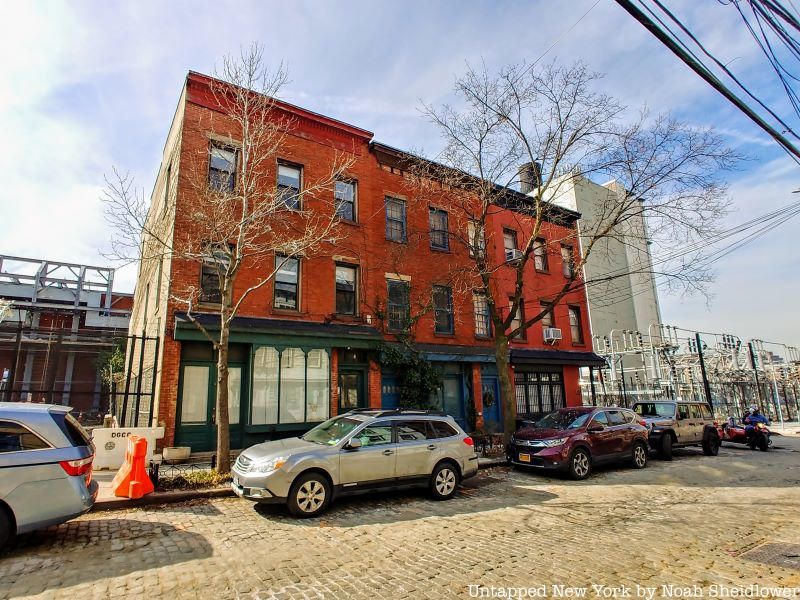
Vinegar Hill primarily consists of Federal and Greek Revival-style homes amid industrial buildings. The Vinegar Hill Historic District, one of the smallest in New York City, has enabled the preservation of much of the historic properties, as well as the area’s picturesque streets. Adding to the quaintness, many of the streets including Hudson Avenue, Plymouth Street, Water Street, and Front Street are paved in belgian blocks (not cobblestones as many call them).
Belgian blocks are rectangular quarried stones used for paving roads, in contrast to cobblestones which are more natural in shape and less uniform in size. Belgian block streets are common in Dumbo and Red Hook, and it is estimated that there are only about 15 miles of Belgian blocks remaining across all of New York City, concentrated mainly at South Street Seaport.
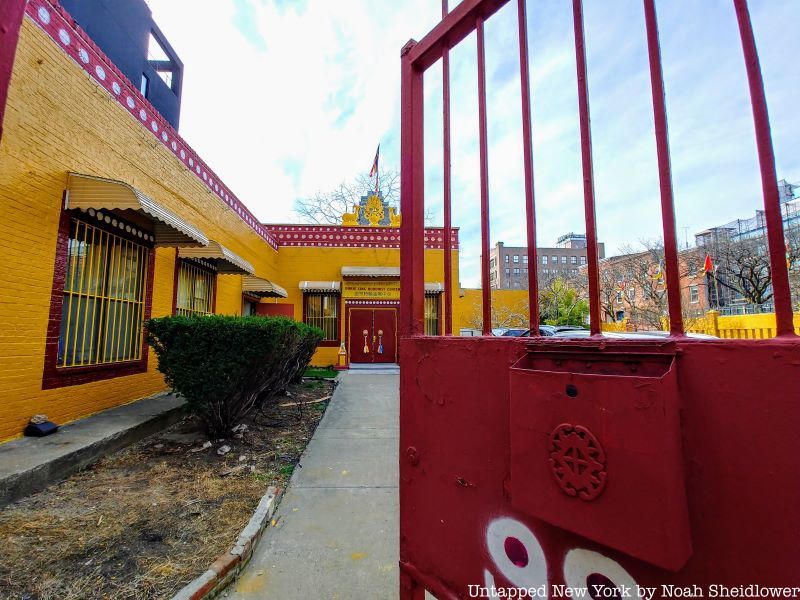
Located at 98 Gold Street, Dorje Ling Buddhist Center is one of Brooklyn’s major Buddhist institutions. The large yellow building, gated off from the street by a yellow and red brick wall as well as barbed wire, features Tibetan prayer flags that add color to the neighborhood.
The Vinegar Hill location opened in 1991, following the Jonang Tibetan Buddhist lineage. The Jonangpa were among the last Tibetan Buddhists to flee after China’s forced annexation in 1950. They are also one of the only sects to follow the Kalachakra Tantra, a religious text on tantric meditation.
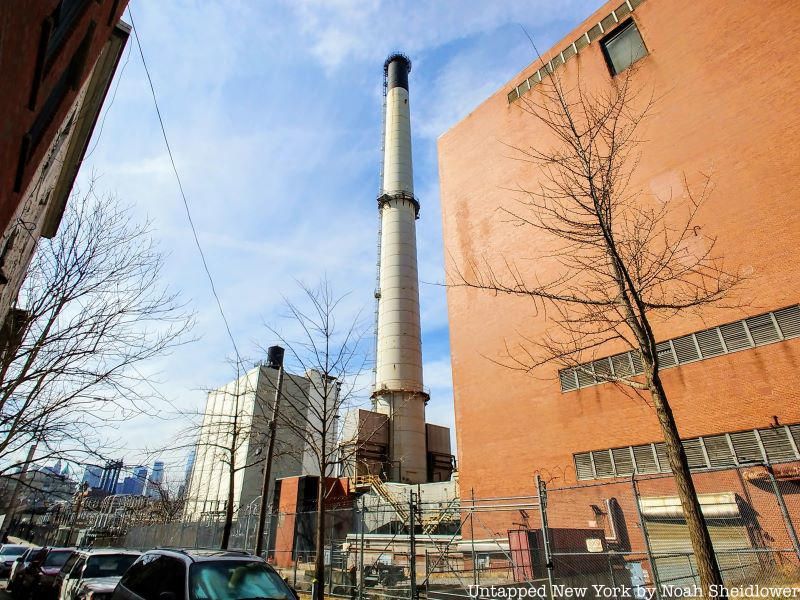
Within Vinegar Hill is the Con Edison Hudson Avenue Substation, which blocks off water access to the waterfront neighborhood. The closest public water access for Vinegar Hill residents is in nearby Dumbo. The substation, though, has lost much of its productivity over the last decade, and there has been much debate concerning what it should be converted to. In 2017, Vinegar Hill substation released 30,000 gallons of transformer oil into the water, which resulted in ConEd paying $636,015 for damages.
Four smokestacks were removed in 2011, though one remains. The smokestack towers over the three-story buildings along Hudson Ave, making for some fascinating photos of urban and industrial coming together.
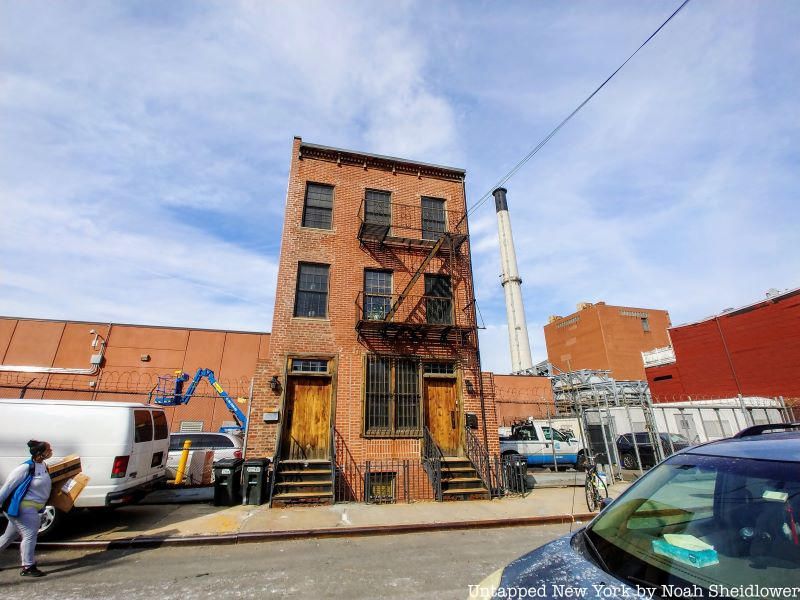
In the mid-19th century, Vinegar Hill was home to illegal distilleries that produced potheen, derived from the Irish word “poitín” meaning little pot. Potheen was a type of “Irish moonshine” distilled in a small pot, often made illicitly using potatoes. The alcohol percentage is usually very high, between 40 to 90% ABV. John Devlin, John Whiteford, “Ginger” Farrell, and “Ned” Brady were the leaders of the potheen business in Vinegar Hill, operating under the radar to avoid having their products confiscated and businesses shut down.
At the time, alcohol was legal but was heavily taxed at about 20 cents per 100-proof gallon. Alcohol was often traded illegally, making the neighborhood significantly more prosperous. The Bureau of Internal Revenue (the precursor to the IRS) was created in 1862 amidst the Civil War and sent in Army veterans to Vinegar Hill to raid the distilleries. In 1869, the Army destroyed stills that could produce 250 barrels of alcohol each day (about $5,000 in taxes, or over $100,000 today), resulting in the “Whiskey Wars.” According to a Smithsonian article, “It looked like a storm had swept through the industrial Brooklyn neighborhood of Vinegar Hill. Whiskey ran through the cobblestones and pooled near the Navy Yard gate. Alleys were strewn with rocks, coal and scraps of wood. Molasses stuck to the streets and the air reeked of sour mash. The remains of some 20 illegal distilleries lay in ruin for all to see, abandoned in mid-production like an unfinished feast.”
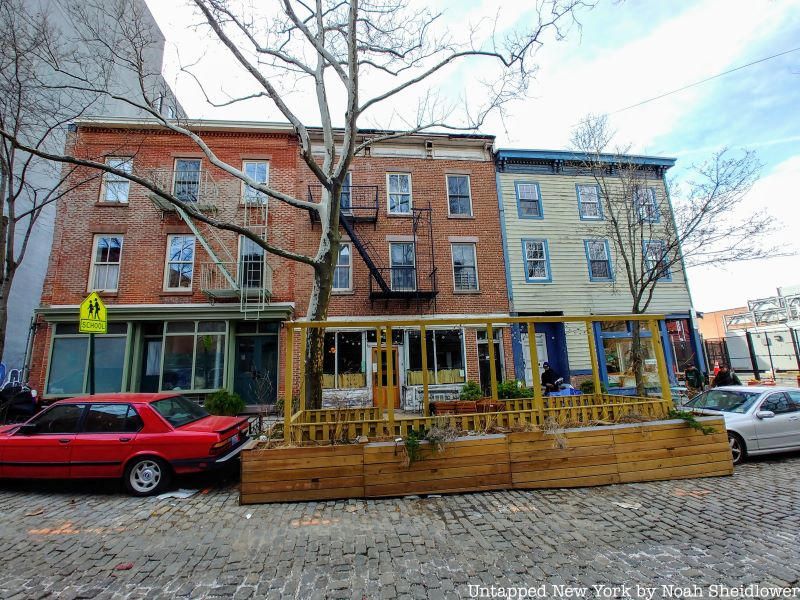
Despite being so close to the water, Vinegar Hill technically only has two restaurants: Cafe Gitane and Vinegar Hill House. Cafe Gitane is a French and Moroccan eatery with locations on Mott Street, Los Angeles, and Tokyo. Located on Hudson Avenue, one of the neighborhood’s main streets, Cafe Gitane boasts popular dishes like pomegranate glazed salmon fillet, yellowfin tuna ceviche, and Moroccan couscous with red peppers, potatoes, raisins, toasted pine nuts, hummus, and eggplant.
Vinegar Hill House is one of the neighborhood’s defining attractions. Located right next to Cafe Gitane, the New American spot has been open since 2008, with rustic wooden accents and lots of art. Dishes include striped bass with heirloom potatoes and sauerkraut butter, red wattle pork chop, and charred octopus.
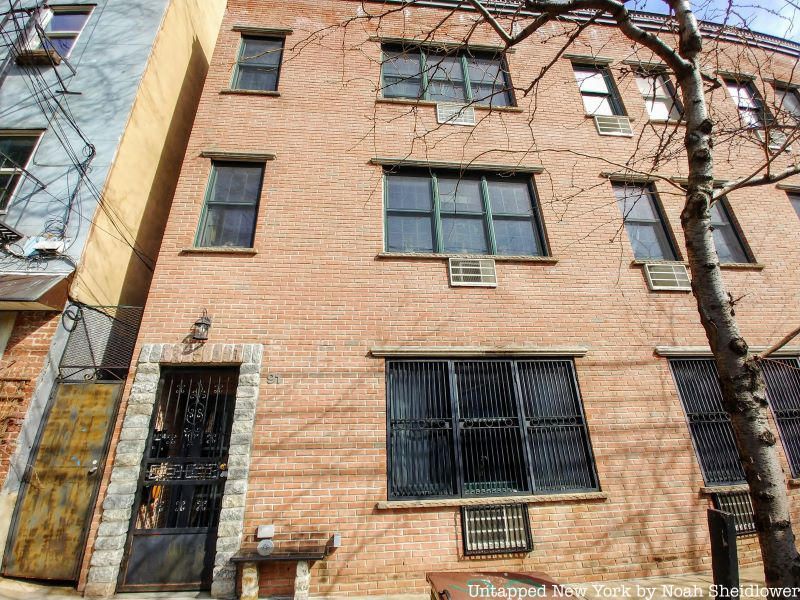
The Prison Ship Martyrs’ Monument in Fort Greene Park commemorates the more than 11,500 American prisoners of war who died in captivity while on British prison ships during the Revolutionary War. More Americans died in British jails and prison ships in the Harbor than in all Revolutionary War battles, and many bodies were thrown overboard in Wallabout Bay. During the construction of the Brooklyn Navy Yard, many of these remains were uncovered and put into boxes and casks, and Stanford White designed the 149-foot-tall granite Doric column memorializing these lives lost.
Before the construction of the Prison Ship Martyrs’ Monument, there was a vault housing some remains that stood at what is today 91 Hudson Ave. On May 26, 1808, a re-internment ceremony was held, and a small square building stood above the vault. A monument was never built on-site because Tammany Hall, which was given $1,000 to build the monument, pocketed the money. Surrounding the triangular plot of land was a wooden fence with thirteen posts painted with the names of the original 13 states. Little was done to maintain the vault, which soon after fell into disrepair.
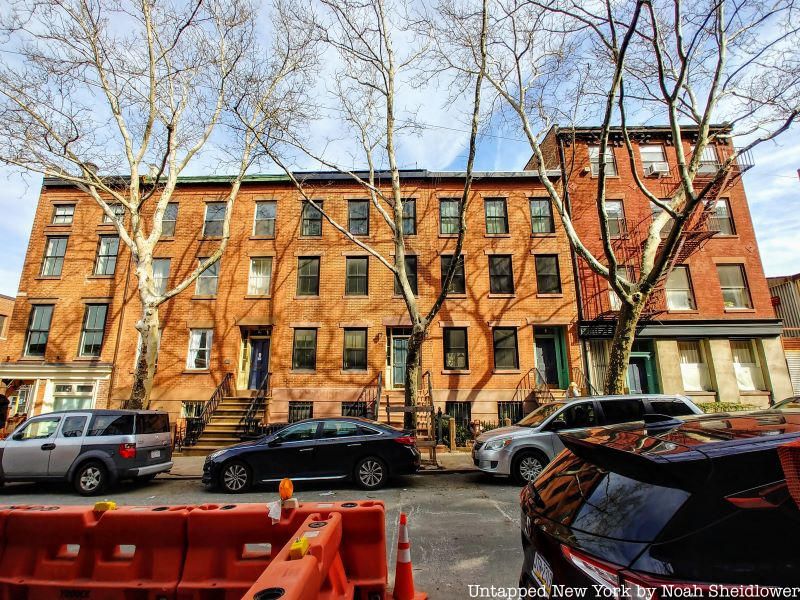
Though not the only spot in New York known as Irishtown — Bay Ridge, Park Slope, and Breezy Point also had historically large Irish populations — Vinegar Hill was one of the more populous. John Jackson, who built a shipyard near Wallabout Bay, tried to attract Irish immigrants to the neighborhood even though Poles and Norwegians originally settled in the area, Many Irish immigrants eventually settled here in part due to its proximity to the Navy Yard, as well as the name Vinegar Hill itself.
After Jackson sold his land to the Brooklyn Navy Yard and helped build additional housing for workers, he named the area in honor of the Battle of Vinegar Hill, an engagement during the Irish Rebellion of 1798. The Battle of Vinegar Hill was the last attempt of the United Irishmen to defend its ground against the British military. The battle was a British victory, with 13,000 British soldiers launching an attack on the United Irishmen headquarters of Vinegar Hill. Casualties on the Irish side are estimated at about 500 to 1,200.
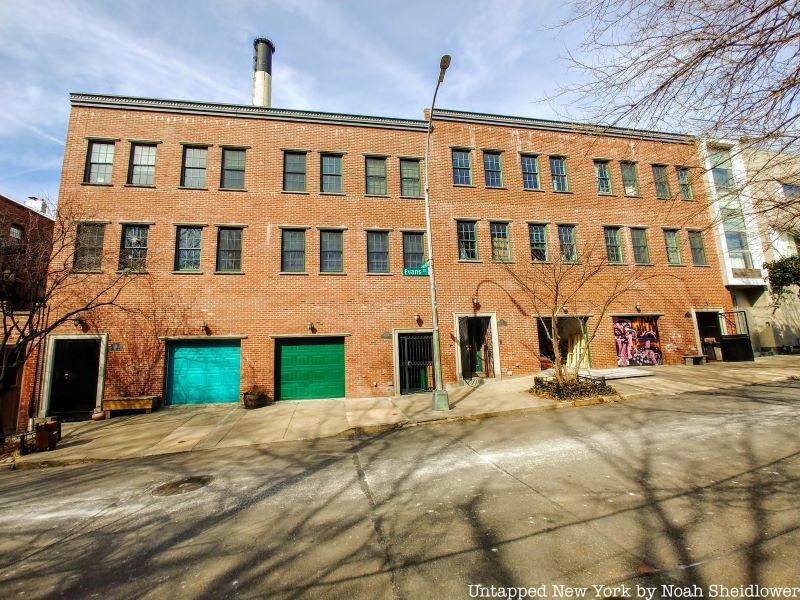
Before becoming Irishtown, Vinegar Hill was developed as a summer destination for New Yorkers following the Revolutionary War. The land, which was bought by Joris Jansen Rapalje and owned by his family, was sold to Comfort and Joshua Sands in 1784, specifically around Gold Street. The Sands family was one of the original three families to settle in Sands Point, north of Port Washington. Both were merchants, and Joshua served as a U.S. Representative from New York.
The Sands family built many blocks for a community they named Olympia in 1787. Olympia was envisioned to be a summer retreat close to the river. However, as New England families moved in, manufacturing facilities were constructed, shifting the ideal destination to an industrial village. Workers and families moved into multi-story brick and wood buildings.
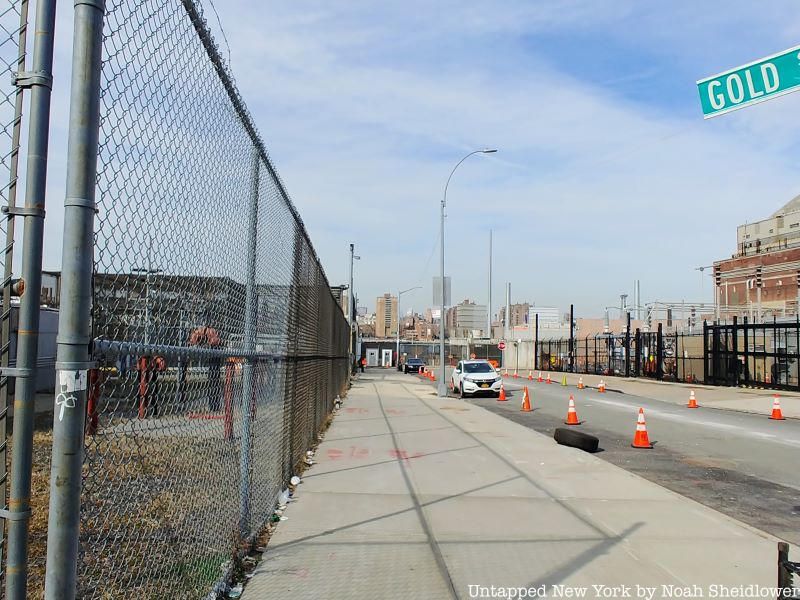
A significant Lithuanian population developed in Vinegar Hill around the 1920s and 1930s, replacing much of the Irish population. According to the 1930 census, the Lithuanian population was approximately 75% of the population in Vinegar Hill , with many arriving between 1905 and 1912. The census recorded a shoe store owner named John Yuska, who paid just $17 in rent per month.
Along Hudson Avenue, many of the shops displayed Lithuanian signs and menus, continuing as late as the 1960s. Lithuanian immigrants built the St. George R.C. Church on York Street, which had services in Lithuanian; it was believed that the church was founded after Lithuanians were not allowed into the two Irish churches in the neighborhood.
Next, check out the Top 12 Secrets of Fort Greene!
Subscribe to our newsletter